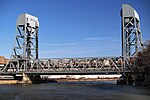Bronx Theatre High School
AC with 0 elementsMarble Hill, ManhattanPublic high schools in the BronxSpuyten Duyvil, Bronx
Bronx Theatre High School is a high school in New York City, on the border of the Marble Hill neighborhood of Manhattan and the Spuyten Duyvil neighborhood of the Bronx. It is currently a small school located within the John F. Kennedy High School building (99 Terrace View Avenue, 7th Floor, Bronx, NY 10463). The enrollment is about 435 students. A large proportion of these students are women, approximately 70%.
Excerpt from the Wikipedia article Bronx Theatre High School (License: CC BY-SA 3.0, Authors).Bronx Theatre High School
Terrace View Avenue, New York Manhattan
Geographical coordinates (GPS) Address External links Nearby Places Show on map
Geographical coordinates (GPS)
| Latitude | Longitude |
|---|---|
| N 40.8775 ° | E -73.913611111111 ° |
Address
Bronx Theatre High School
Terrace View Avenue 99
10463 New York, Manhattan
New York, United States
Open on Google Maps








